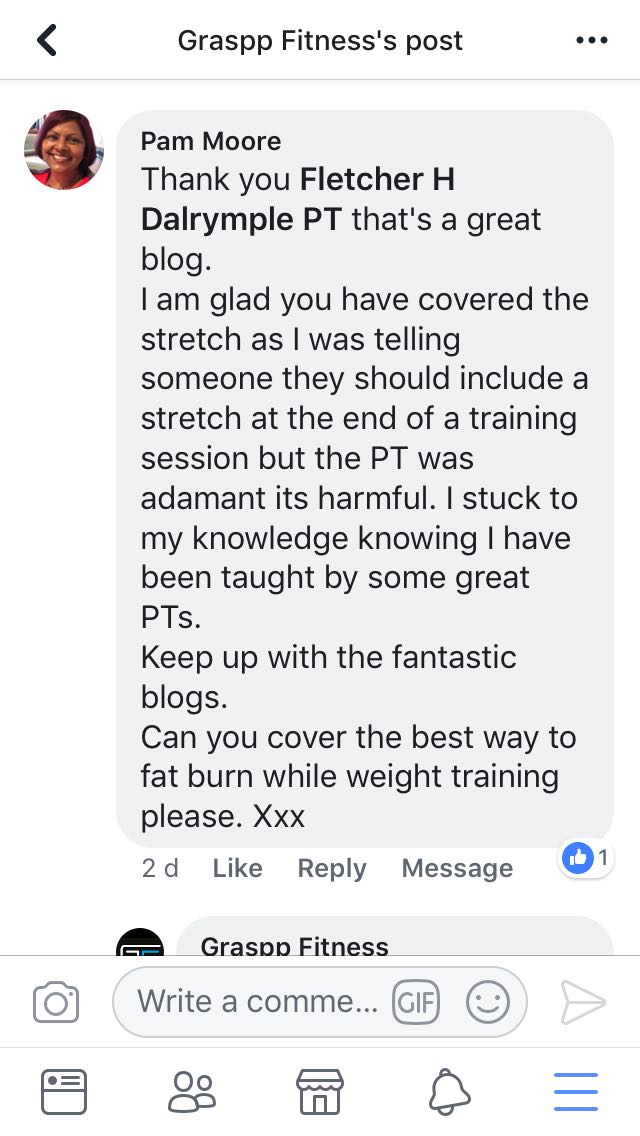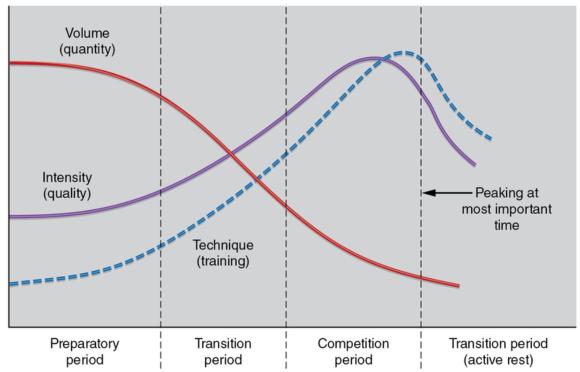
The question from Pam Moore was “How do I burn more calories/increase levels of fat loss using free weights?”
The answer is in many different ways.
So I’m not going to stretch people’s concentration spans; for tonight, I’ll just give you one suggestion.
Now, this is with the understanding that the client is on top of their deficit (the calorific one, discussed here).
They have worked out which diet is most optimal for them. And if needed, they have had blood work taken, and hormone profiling done, to assess which, if any, supplements they need. Plus their sleep and stress are managed! This is a big factor.
So if you have checked off that list, here is a suggestion for you that I have seen work very well.
This is also post-pulse raiser, mobility and activations. Then you must’ve fired up your CNS, and now we’re ready to train.
Now science says that intense resistance training will have a metabolism-boosting, fat loss-enhancing effect for hours after. But we a) need markers of progression, i.e. periodisation or gradual gains in strength and or volume, and b) intensity is purely individual, so you must work and improve YOUR work capacity.
In this example, and after the necessary warm up, we are going to focus on a compound movement.
For this example’s sake, we’ll use a hinge pattern. Let’s say a Trap Bar Pull or Deadlift from blocks. Movements more of the general population can benefit from.
We are working with easier percentages peaking weekly with loads that are 75%, 80% and then 85% of our predetermined (training) max. And on the 4th week, we let the system rest with a de-load. The de-load will involve a complete rest of the movement (but not the pattern!), so for example pull throughs, swings or hyperextension variations will make a nice change. The following wave should have a small increase in your training max if the wave was a success.

This is a rough guide. The percentages are just there as guidelines for the level of intensity, and a very basic example of periodisation (one of our makers of improvement). You could use a 5-3-1 template or similar, but explaining this will be for another blog.
With the requisite volume/intensity in the compound lift completed, we’re going to look at a list of exercises we can combine with our hinge pattern to create a global training effect.
Global Training Effect Exercise List
So, let’s start by using a single leg variation that is anterior in nature, as the hinge is a posterior chain movement. So we could have a forward split lunge or lunge variation, or single leg squat pattern/step up or step down.
For the upper body a horizontal rowing pattern. A dumbbell/kettlebell/machine/TRX/cable row variation to name a few.
The opposite for the anterior (front of the body).Pushing overhead using either a single arm KB press or neutral dumbbell press/landmine variation.
For the upper back, a face pull-apart or similar upper back movement.
For core, a press-up plank is a valid option, with a movement of the hands or feet for 30 seconds.
Kettlebell or Dumbbell swing as an extra dynamic element that helps reinforce those all-important posterior chain muscles.
Now we’re looking at a nice little selection of movements covering the primal movement patterns. The exception being the squat pattern which could be the basis of the next strength training session.
Now, what to do with it?
Well, let’s put them in a (metabolic) conditioning circuit or sequence. All metabolic conditioning really means is a structured sequence of exercises that is programmed for optimum efficiency
We’re going to program the exercises upper to lower, forcing the heart to work very hard to redirect blood flow.
An example could be:
- Anterior Split lunge with ( or without) load, for 8-10 reps per leg, moving into.
- One-armed row variation (although this is open to personal preference, think row variation) for 10-12 reps (per arm), followed by.
- KB swing for 8-10 reps, moving into.
- Standing (or seated/kneeling/split stance/single arm or bilateral) press variation for 8-10 reps.
Active rest can be a tall press-up plank with a movement for 30 seconds, or standing Palof press (banded or cable) for 8 per side. Rest up to 2 mins, and repeat for up to 4 full circuits. The rest between exercises is minimal, but not a race. Set up and execute perfectly.
This will fire up the metabolism, burn extra calories for hours, develop great work capacity, and still develop strength and build muscle.
You could also do them as a sequence. This would involve the same/similar exercises and order, but allow a little more rest (let’s say up to 60 seconds but more can be taken) between exercises, and be using greater loads.
Both methods yield great benefits.
In Summary
The studies show that is a COMBINATION of resistance training and aerobic conditioning that is the most effective for fat loss.
In this case, we have already pursued some high-intensity resistance training so let’s move to some low-intensity cardiovascular exercise. It can help us cool down, disperse waste products, stop blood pooling, and yes, even help towards burning a few extra calories. Work in Zone 2 (65-75%) of your heart rate for 10 mins plus.
Followed by stretching the usual suspects with the development of flexibility and recovery in mind, and a little foam rolling/trigger point work. This will help us to recover faster and get back in the gym sooner.
I would adopt a high-low approach. A day of intense training followed by an active rest/recovery day. Easy CV, mobility, stretching, self-myofascial release, a yoga class, get outdoors and walk or hike, swim, meditate.
And when your body needs it, rest. Where it feels appropriate, listen to your body.
But I started and I will finish with this. If you are looking to optimize the benefits of exercise with fat burning in mind, then the science is pretty black and white. This should be in a hyper-caloric deficit.
The takeaway is that muscle will help you stay lean (not to mention strong and less likely to die!) This happens because of the increase in your Basal Metabolic Rate. Every kilo of lean muscle tissue uses around 10 kcal per hour.
One of the many effects of resistance training is an increase in your RRE (Resting Rate of Expenditure). This remains higher for many hours post intense resistance training. And this, in the fight for fat loss, is one of the most important factors alongside the dreaded deficit of calories, the right combination of macros, and selecting food types to suit your body.
There are many ways to skin the proverbial cat. This is just one.
Remember there is no shortcut or magic bullet, only consistency.
I just hope it helps.
Stay strong,
Coach Fletch.
Author - Fletcher Dalrymple - Personal Trainer & Mentor

Like what you read? Want to know more?
If you have a question about anything Health & Fitness that you want to see answered in a future article, or even fancy treating your brain & body to a whole day with one of our brilliant Mentors. Please contact us – we will endeavour to get back to you within 24hrs!
Remember – It is never too late to bulletproof your future self.
